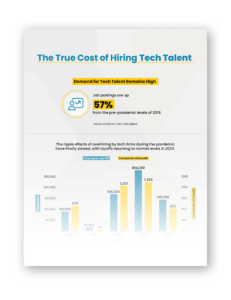In brief:
- Amid a rising tide of sophisticated cyberthreats and a shortage of skilled security professionals, cybersecurity is now the #1 business function outsourced.
- AI has shifted the cyberthreat landscape into high gear, with 97% of security professionals concerned their organization will suffer an AI-generated attack.
- Managed security services provide continuous monitoring, threat detection, and incident response to protect businesses from cyberthreats.
- Key managed security services benefits include access to top-tier talent, advanced, top-in-class tools, 24×7 protection, and best practices without the headache and expense of standing up your own Security Operations Center.
In today’s digital landscape, cybersecurity is no longer a peripheral concern but a fundamental business imperative. In response, more organizations are turning to the benefits of managed security services to strengthen their defenses – making cybersecurity the #1 outsourced function.
As the 2025 Allianz Risk Barometer points to cybersecurity as the top business risk for the fourth consecutive year, cybersecurity and IT infrastructure services rose to the top of the list on Deloitte’s Global Outsourcing Survey 2024 as the functions companies are outsourcing the most. Some 77% of organizations now outsource cybersecurity processes to a third-party provider, surpassing more traditional areas like Finance, the report showed.
That marks a significant jump from 2023, when Computer Economics’ IT Outsourcing Statistics Report found that cybersecurity was the least-outsourced IT function, with only 40% of IT departments outsourcing cybersecurity work.

So, what’s driving the increase?
The number of cyberthreats – and financial implications of a successful attack – are staggering. Consider these statistics:
- The average number of weekly attacks per organization climbed to an all-time high of nearly 1,900 in the third quarter of 2024 – a staggering 75% increase from the same period in 2023 (Check Point’s 2025 Cyber Security Predictions report).
- The average global cost of a data breach reached a record high of $4.88 million in 2024. In the U.S., costs are nearly double at $9.36 million – the highest of any country (IBM’s Cost of a Data Breach Report 2024).
- Rapid advancements in artificial intelligence (AI) have dramatically shifted the cyberthreat landscape, enabling more sophisticated attacks in high-impact areas like phishing emails, while reducing the cost of executing attacks by as much as 95% (Harvard Business Review).
- 75% of security professionals had to adjust their cybersecurity strategy in the past year due to the surge in AI-powered threats (Deep Instinct’s 2024 AI in Cybersecurity report).
But despite the clear and growing need for robust cybersecurity, many companies struggle to manage their security effectively in-house. This often stems from several pain points, including difficulty attracting and retaining skilled cybersecurity professionals, high costs associated with building and maintaining an in-house security team and infrastructure, the challenges of providing 24/7 monitoring and response, and the need to constantly keep pace with evolving threats and regulatory requirements.
This is where the benefits of managed security services become increasingly apparent. Read on to discover five powerful benefits of cybersecurity managed services for your business:
1. Overcome the cybersecurity skills shortage with top-tier talent
One of the most significant drivers for outsourcing cybersecurity services is the global shortage of cybersecurity professionals. In the U.S. alone, Cybersecurity Ventures reports more than 750,000 cybersecurity job vacancies, with the demand-supply gap expected to persist.
This shortage makes it incredibly challenging and expensive for organizations to build and maintain a highly skilled in-house security team. Amid stiff competition for top talent, cybersecurity jobs are commanding some of the highest salary brackets in IT today.
More than half of organizations that suffered a data breach in 2024 were grappling with a cybersecurity skills shortage, states the IBM Cost of a Data Breach 2024 Report.
Outsourcing cybersecurity to a managed security services provider (MSSP) helps enterprises tackle these challenges, offering immediate access to a cost-effective team of certified and experienced cybersecurity professionals without the overhead of recruitment, training, and retention.
Nearshoring to Latin America amplifies these benefits by offering the real-time collaboration, smooth communication, cultural alignment, and deep pool of skilled tech talent needed to swiftly address and resolve urgent security issues. As high attrition continues to plague the saturated labor markets in traditional Asia-based outsourcing destinations, IT organizations are increasingly turning to Latin America – with CBRE’s Scoring Tech Talent 2024 report ranking Latin America as the top up-and-coming tech market globally.
The report recognizes San José, Costa Rica as the fastest-growing tech market in LATAM, with locations in Costa Rica, Colombia, Mexico, Argentina, Chile, Panama, and Brazil comprising the top 10 nearshore markets for tech talent.
IT services are now successfully performed by 64% of shared services in Latin America, compared to 32% of shared services globally, states the 2024 State of the GBS and Outsourcing Industry in Latin America report by SSON Research & Analytics and Auxis. That finding is underscored by Computer Economics’ IT Outsourcing Statistics report, with IT leaders ranking physical proximity as the #1 factor for choosing an IT outsourcing provider due to reduced operational challenges – even if a lower cost could be found in a more distant location.

2. Leverage cutting-edge tech without a big upfront investment
Maintaining state-of-the-art cybersecurity infrastructure that can keep pace with today’s threats requires significant and ongoing investment in both hardware and software. The best MSSPs solve this problem with a suite of advanced cybersecurity tools and emerging technologies like AI and automation.
In addition, a quality partner should offer the flexibility to use or integrate with your existing security tools while also bringing their own advanced capabilities. This allows businesses to leverage cutting-edge technology and enterprise-grade cybersecurity solutions that might be too costly or complex to implement on their own, with your MSSP further absorbing the ongoing cost of maintenance and upgrades.
MSSPs also tend to be better positioned to leverage new technology to defend against emerging AI threats. Outsourced security teams are experienced in administering and utilizing advanced security tools across various clients and industries, reducing the need for internal teams to undergo extensive upskilling or training.
With cybersecurity their exclusive focus, managed security services are also dedicated to staying on top of the fast-changing threat landscape. More than half of IT leaders are already witnessing AI-powered attacks within their organizations – and 35% feel they lack necessary defenses, according to the 2024 Keeper Security Insight report. AI-powered phishing has emerged as a top concern, with 42% of IT leaders identifying it as their primary security risk.
Large language models (LLMs) can automate the entire phishing process, significantly reducing the cost of attacks and making them more widespread and sophisticated. Some 84% of IT leaders report that phishing and smishing (attacks via text messages) have become harder to detect due to AI-powered tools, Harvard Business Review found.

On the flip side, organizations recognize AI’s potential for enhancing cybersecurity, bringing an unprecedented ability to quickly analyze vast amounts of data for anomalies, detect attacks humans might miss, predict threats, minimize damage by automatically responding to incidents in real-time, and more. Organizations that leverage AI and automation extensively for proactive prevention experience 46% lower costs from a data breach than those that do not, IBM reports.

A quality provider brings the knowledge and expertise to help you choose the right AI tools and build a governance framework that prioritizes security and privacy for AI deployments, ensuring AI defends against existing and emerging threats rather than amplifies vulnerabilities. Unintentional data breaches caused by employees sharing sensitive information with AI models like ChatGPT and Google Gemini are a top security risk in 2025.
3. Access 24x7x365 threat protection
Cyberthreats don’t adhere to business hours. For short-staffed internal IT teams with multiple priorities, monitoring and responding to security alerts after hours, on weekends, and during holidays can be a significant challenge – potentially allowing threats to slip through the cracks.
The daily reality for internal security teams is often a deluge of security alerts. Security Operations Center (SOC) staff are overwhelmed by an average of 3,800+ alerts per day, with 62% ignored due to excessive workload and inefficiencies in security tools, a 2024 Vectra AI survey states.
This overwhelming number directly underscores a critical problem that MSSPs are designed to solve: the risk of missing genuine threats amidst the noise.
Nearly 60% of IT teams spend more than 20% of their time just trying to determine which alerts deserve their immediate attention, an Orca Security survey found. This struggle leads to another alarming finding: 55% of IT teams missed critical alerts due to ineffective alert prioritization – sometimes on a weekly, and even daily, basis.
Beyond sifting through alerts, the actual investigation of each incident consumes significant time and resources. International Data Corporation (IDC) estimates that investigating a single alert takes approximately half an hour.
When compounded by thousands of daily alerts, this time burden can quickly exhaust the capacity of an in-house IT team. Even seemingly routine security tasks, such as addressing a single phishing email, take IT teams an average of 28 minutes and $31 to resolve, states Osterman Research’s The Business Cost of Phishing report.

Partnering with an MSSP can help organizations overcome this alert overload, gaining access to round-the-clock security monitoring and incident response.
Unlike internal IT teams working fixed schedules, quality MSSPs operate SOCs that function 24 hours a day, 7 days a week, 365 days a year for a wealth of clients across industries. While internal IT teams juggle multiple responsibilities, MSSPs are solely focused on cybersecurity, ensuring continuous monitoring and threat detection.
In addition, quality MSSPs employ automation to significantly reduce the volume of alerts and streamline investigations by leveraging technologies such as Security Information and Event Management (SIEM), Extended Detection and Response (XDR), and Security Orchestration, Automation, and Response (SOAR) platforms. These tools use predefined rules, threat intelligence, and machine learning to filter out false positives and correlate events across multiple systems, helping to prioritize real threats.
Automated workflows can triage alerts, enrich data with contextual information, and even take predefined response actions — such as isolating devices or blocking IP addresses —without human intervention. This not only reduces alert fatigue for analysts but also accelerates response times and improves overall threat detection and management efficiency.
This constant vigilance ensures potential threats are detected and addressed in real-time, minimizing the window of opportunity for attackers and reducing the potential impact of security incidents. In addition, MSSP partners provide scalability and flexibility, enabling you to easily adjust your security resources and services up or down based on evolving needs.
4. Lower costs without lowering your guard
Building and maintaining a robust in-house cybersecurity team involves substantial costs related to recruitment, salaries, benefits, training, and the procurement and management of security technologies.
2024 State of the GBS and Outsourcing Industry in Latin America

The cost of maintaining a robust in-house security posture is steadily increasing. Security spending as a percentage of overall IT expenditure rose from 8% in 2020 to 13% in the past year, a 2024 IANS Research report showed.
This upward trend highlights the growing financial pressure on organizations to manage security internally. By partnering with an MSSP, IT leaders can achieve greater cost efficiencies through labor arbitrage, optimized operations, and the ability to avoid the significant investments required to build and maintain a fully staffed and equipped SOC in-house.
Quality MSSPs deliver turnkey security operations equipped with world-class talent, tools, and best practices. This can lower overall cybersecurity costs and maximize the return on investment.
For example, CBRE’s Tech Talent report found the annual wage for tech talent in Latin America’s top markets averages 38% lower than hiring the same resources in the U.S. – helping to lower costs while LATAM’s quality talent ensures the highest performance.
Moreover, the cost savings achieved through nearshore labor arbitrage can be strategically reinvested to self-fund security enhancements like automation and AI.
5. Leverage best practices & process optimization
The cybersecurity landscape is constantly evolving, with new and sophisticated threats emerging regularly. Addressing these advanced cyber-risks requires specialized knowledge and up-to-date expertise that can be challenging for general IT teams to maintain.
One of the biggest benefits of outsourcing security services is instant access to a team of experts with extensive experience implementing security best practices and navigating the complexities of the modern threat landscape. Quality MSSPs work with clients across industries, gaining exposure to a wide range of threats, compliance requirements, and best practices that single IT teams might not encounter. With experience handling countless security incidents, the best cybersecurity service providers continuously refine best practices and implement structured, battle-tested frameworks for rapid incident response.
MSSPs further leverage global threat intelligence gleaned from diverse clients and industries, allowing them to anticipate and counteract emerging cyberthreats more effectively. They also are well-versed in compliance frameworks like NIST, SOC 2, and HIPAA, helping customers avoid fines and security gaps.
Because MSSPs serve multiple clients, they can further afford to invest in continuous staff training and proactive threat hunting — keeping them more informed and prepared than most in-house teams.
Quality providers also operate under service-level agreements (SLAs) that drive continuous improvement in service delivery.
Why Auxis: Decrease costs and increase protection
The increasing sophistication and frequency of cyberthreats, coupled with the challenges of building and maintaining in-house security expertise, are driving more and more organizations to embrace MSSP benefits. The right cybersecurity partner offers a compelling solution for strengthening your security posture, providing access to top-tier talent, cutting-edge technologies, 24/7 protection, lower costs, and optimized operations.
With more than a quarter-century of experience, large enterprise and middle-market businesses rely on Auxis to fortify their organizations against today’s fast-changing landscape of cyberthreats. Its comprehensive SOC solution doesn’t just manage security, it takes it to the next level – bringing a highly collaborative and consultative approach that ensures long-term resilience against cyber-risks.
Auxis stands out in a crowded security market with the flexibility to adapt its services to the specific and unique security needs of each business. Auxis also comes to the table with proprietary AI and automation solutions, partnerships with best-in-class technology providers, and a nearshore delivery model that offers access to top-tier security talent at a fraction of the cost.
By partnering with Auxis, you can act with confidence knowing your data and infrastructure are protected around-the-clock – ensuring a continuous and proactive security stance without overloading your internal teams.
Want to strengthen your cybersecurity stance with expert-driven protection? Schedule a consultation with our cybersecurity experts today! You can also visit our resource center for more IT security tips, strategies, and success stories.
Frequently Asked Questions
How do I choose the right managed security services provider?
+Selecting the right MSSP involves evaluating their expertise, technology, and service offerings. Look for managed service providers with strong industry experience, 24/7 monitoring capabilities, AI-driven threat detection, and compliance with relevant security standards. Consider their flexibility to integrate with your existing security tools and ensure they offer clear service-level agreements (SLAs) for performance guarantees.
What kind of security threats can managed security services help protect against?
+MSSPs help defend against a wide range of cyberthreats, including malware, ransomware, phishing, insider threats, and Distributed Denial-of-Service (DDoS) attacks. They also provide protection against emerging AI-powered cyberthreats, cloud security vulnerabilities, identity-based attacks, and more, ensuring a proactive defense strategy.
How does a Security Operations Center work?
+A Security Operations Center (SOC) is a centralized team of cybersecurity experts who monitor, detect, and respond to threats in real time. Using advanced tools and automation, SOC analysts analyze security alerts, investigate incidents, and take action to mitigate risks. A well-equipped SOC operates 24/7, continuously improving security postures by adapting to new threats and vulnerabilities.
What are the costs associated with managed security services?
+The cost of MSSP services varies based on factors like the level of monitoring, incident response capabilities, and the size of the organization. Pricing models may include fixed monthly fees, per-user or per-device costs, and additional charges for specialized cybersecurity services. While outsourcing security requires an investment, it is generally more cost-effective than building and maintaining an in-house security team.




